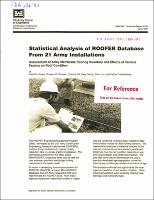Please use this identifier to cite or link to this item:
https://hdl.handle.net/11681/27341Full metadata record
| DC Field | Value | Language |
|---|---|---|
| dc.contributor.author | Bailey, David M. (David Michael), 1957- | - |
| dc.contributor.author | Simpson, Douglas G. | - |
| dc.contributor.author | Geling, Olga | - |
| dc.contributor.author | He, Xuming | - |
| dc.contributor.author | Lau, Shun | - |
| dc.contributor.author | Trachtenberg, Felicia | - |
| dc.date.accessioned | 2018-06-18T14:39:58Z | - |
| dc.date.available | 2018-06-18T14:39:58Z | - |
| dc.date.issued | 1997-06 | - |
| dc.identifier.govdoc | USACERL Technical Report 97/83 | - |
| dc.identifier.uri | http://hdl.handle.net/11681/27341 | - |
| dc.description | Technical Report | en_US |
| dc.description.abstract | The ROOFER Engineered Management System (EMS), developed by the U.S. Army Constrnction Engineering Research Laboratories (USACERL), enables Anny installations to capture roofing inspection data in a single electronic database. The automated component of the EMS, called MicroROOFER, processes these data to help the user evaluate, prioritize, and budget roofing maintenance and repair needs. To assist in developing future enhancements for ROOFER, USACERL acquired MicroROOFER databases from 21 Army installations that have implemented the ROOFER EMS. From these separate databases researchers created a master data set containing inventory data, inspection data, and condition indices for 3059 roofing sections. The researchers conducted a statistical analysis of the data set to characterize the inventory sample and detennine how the roof condition depends on age and various design and construction factors. The data also were used to demonstrate the use of specially developed age/degradation curves for detennining condition percentiles as functions of age. The analysis confinned that age is by far the most important predictor ofroof section condition. Other influential predictors were surfacing, flashing type, drainage, and membrane type. | en_US |
| dc.description.sponsorship | US Army Center for Public Works. | en_US |
| dc.description.tableofcontents | SF 298 .1 Foreword 2 List of Tables and Figures 4 1 Introduction 5 Background 5 Objective 5 Approach 6 Scope 6 Mode of Technology Transfer 7 2 Data Selection and Characterization 8 Data Merging 8 Preliminary Analysis of Roof Age 9 Frequency Analysis of Design and Construction Factors 12 3 Statistical Model 15 Model Development 15 Relations Between Predictive Variables and Condition Indexes 18 Interactions Between Insulation Type and Membrane Type 20 Variation Between Installations 21 Proportion of Variance 21 Cross-Validation Estimates of Prediction 22 Predictive Model 23 4 Quantile Plots and Degradation Curve Development 25 5 Summary and Recommendations 27 Summary 27 Recommendations 27 References 28 Distribution | - |
| dc.format.extent | 36 pages | - |
| dc.format.medium | PDF/A | - |
| dc.language.iso | en_US | en_US |
| dc.publisher | Construction Engineering Research Laboratories (U.S.) | en_US |
| dc.relation.ispartofseries | Technical report (Construction Engineering Research Laboratories (U.S.)) ; no. 97/83 | - |
| dc.rights | Approved for public release ; distribution is unlimited. | - |
| dc.source | The ERDC Library created this digital resource using one or more of the following: Zeta TS-0995, Zeutchel OS 12000, HP HD Pro 42-in. map scanner, Epson flatbed. | - |
| dc.subject | Roofs--Maintenance and repair | en_US |
| dc.subject | Military bases | en_US |
| dc.title | Statistical analysis of ROOFER database from 21 Army installations : assessment of Army membrane roofing inventory and effects of various factors on roof condition | en_US |
| dc.type | Report | - |
| Appears in Collections: | Technical Report | |
Files in This Item:
| File | Description | Size | Format | |
|---|---|---|---|---|
| USACERL Technical Report 97_83.pdf | 4.98 MB | Adobe PDF |  View/Open |